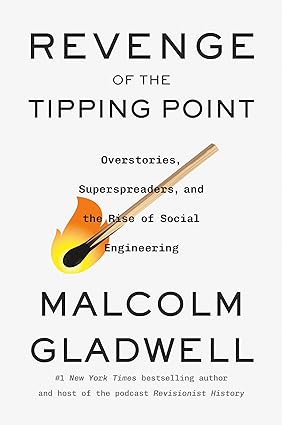- The Good: Disparate ideas that come together in a compelling narrative
- The Bad: Loose organizing framework
- The Literary: Read by the author, the audiobook is very engaging
A quarter century after his first book, The Tipping Point: How Little Things Can Make a Big Difference, Malcolm Gladwell returns to his examination of the “moment of critical mass”, the mysterious point at which ideas and products and sociological changes spread. Using an entirely new set of examples, Gladwell reframes the lessons of The Tipping Point.
While I enjoyed The Tipping Point, I really only picked up Revenge of the Tipping Point because I enjoy Gladwell’s style and prose. I honestly didn’t have high expectations for new material, but I am pleasantly surprised. In both books, Gladwell manages to reveal phenomena that are right in front of us, using a blend of anecdotes and storytelling.
But whereas the last book was bright and optimistic, focusing on falling crime rates and pioneering children’s programs like Sesame Street and Blues Clues, Revenge of the Tipping Point speaks to the near-extinction of cheetahs in captivity, ethical dilemmas like the race wars and white flight, contagious teen suicide, rampant insurance fraud, and how Ivy League schools maintain the ideal (high) ratio of white students by recruiting kids from elitist sports like rowing, sailing, and rugby.
So what do all these anecdotes add up to? Gladwell frames these topics into a story of social engineering as explained through the idea of the magic third, in which profound shifts occur when a minority reaches roughly one-third of a population, superspreaders, in which rare individuals play a much larger role in propagating ideas, behaviors, or even diseases, and lastly, overstories, which are the stories that shape an often localized group and influence individuals to conform. Be aware, the above frameworks feel quite loose and exist more for the sake of debate than the typical persuasive essay.
However, all the stories themselves are fantastic. It’s fascinating to hear examples of the above, including two major recent epidemics, the opioid crisis and COVID, but also television shows that changed our collective ways of thinking about difficult subjects, without our even realizing it.
Gladwell doesn’t pretend to have all the answers; instead, he’s noticing trends and then asking some interesting ethical questions. When is it acceptable to engineer social outcomes? Who gets to decide? What happens when well-intentioned interventions backfire and what can we do to prevent them, or how do we at least acknowledge our own mistakes?
Highly recommended for fans of Gladwell, but also anyone interested in social science. No need to read The Tipping Point before picking up this one.
